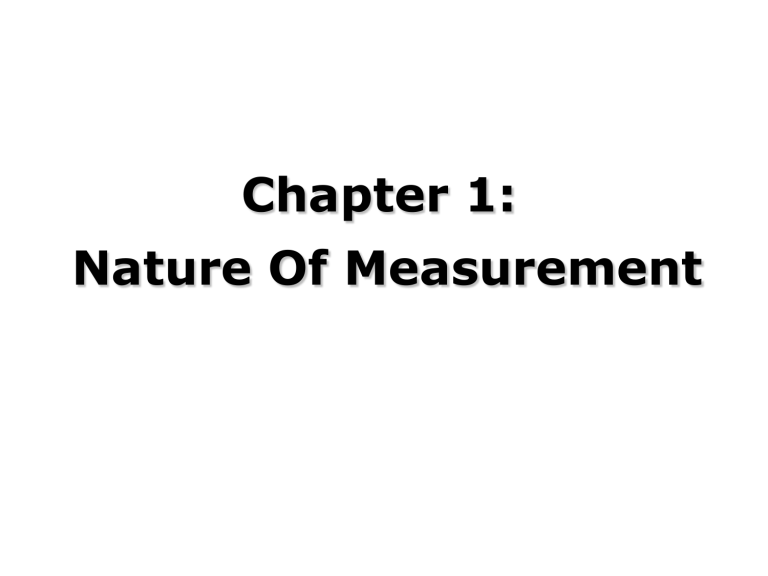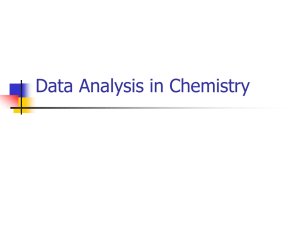
Chapter 1: Nature Of Measurement INTRODUCTION Measurement : quantitative observation consisting of number and scale (unit)) Examples: length: 2.2 m force: 4.45 kg m/s2 SI UNITS International System of Unit (Système Internationale d’Unites) Based on metric system (?) Is a decimal system of units for measurements of mass, length, time and other quantities which can be built from 7 base units: SI BASE UNITS Measurement Unit Symbol meter m Mass kilogram kg Time second s kelvin K Mol Mol Electrical current ampere A Luminous intensity candela cd Length Temperature Amount of substance SI PREFIX Prefix Meaning Symbol Factor value 1012 109 106 103 1000000 1000 tera giga mega kilo millions of thousands of T G M k deci tenths of d 10-1 0.1 centi hundredths of c 10-2 0.01 milli thousandths of m 10-3 0.001 micro millionths of 10-6 0.000001 nano billionths of n 10-9 0.000000001 pico trillionths of p 10-12 0.000000000001 Quantities differing from the base unit by powers of ten are noted by the use of prefixes. COMMON UNITS USED IN LABORATORY MEASUREMENTS -LENGTH -MASS -TEMPERATURE -VOLUME LENGTH The SI unit for length, the meter (m) is too large for most laboratory purposes. More convenient units are the centimeter (cm) and millimeter (mm). 1 cm = 10-2 m = 0.01 m 1 mm = 10-3 m = 0.001 m 1 m = 100 cm = 1000 mm 1 cm = 10 mm MASS Def.: amount of matter in an object SI unit for mass: kilogram (kg) But the more convenient is gram (g) used for most laboratory measurement. 1 kg = 1000 g 1g = 1000 mg 1 mg = ? G 1 g = ? g TEMPERATURE SI unit: Kelvin usually measured with a thermometer Three common scales: degrees Celsius = oC Kelvin = K degrees Fahrenheit = oF Mathematical formulas to convert: K = oC + 273 oC = K - 273 oF = (1.8 x oC) + 32 VOLUME Is derived unit with dimensions of (length)3 Unit: m3 In chemistry, usually we measure amount of liquids. The traditional metric unit of volume: liter (L) 1 L = 1000 cm3 1L= _?_ m3 the glassware we normally use is marked in milliliters (mL) 1 L = 1000 mL 1 mL = 1cm3 DERIVED UNITS Measurement Definition Symbol Area Length x width m2 density Mass/volume kg/m3 Speed Distance / Time m/s Acceleration Change in speed / Time m/s2 Force Mass x Acceleration (kg.m)/s2 (newton, N) pressure Force/area kg/(m.s2) Pascal, Pa energy Force x length (kg.m2)/s2 Joule, J 60 min in one hour 60 min PER hour 60 min 1hour and PER expression 1hour 60 min 60 minutes = 1 hour Conversion factor is written as a fraction Conversion factors: 60 min 1hour and 1hour 60 min a) how many minutes in 2.72 hours? 60 min 2.72 hours x 1hour = 163 minutes b) how many hours in 250 minutes? 259 min x 1hour 60 min = 4.32 hours Example 1: Perform the following conversions a) 255 nm = ? cm b) 0.12 kg = ? cg c) 1 L = ? dm3 a) 255 nm = ? cm SI prefix: 1nm = 1 x 10-9 m 1m = 100cm Conversion factor: 1nm and 1 x 10-9 m 100cm 1m 1 x 10-9 m 1nm and 1m 100cm nm 255 nm x cm 1 x 10-9 m 1nm = 2.55 x 10-5 cm x 1cm 1 x 10-2 m b) 0.12 kg = ? cg (0.12 kg) 1 x 103 g 1kg = ? 1cg 1 x 10-2 g c) 1 L = ? dm3 1 L = 1000 mL = 1000 cm3 1000 cm3 x 1000 cm3 x 1m 100 cm 1 m3 1 x 106 cm3 3 x 1dm 3 1 x 10-1 m x 1dm3 1 x 10-3 m3 = ? dm3 Exercise 1: The block of wood pictured below has a mass of 2.52 kg. What is the density of the wood in g/cm3 6.2 cm 5.1 cm 1.08 m Solution Change the mass from kg to g Change the length from m to cm The volume of the wood: The density of the wood: Exercise 2: 1. Perform the following conversions: a) 0 oC to oF and K b) 100 oC to oF and K 2. The average density of earth is 5.52 g/cm3. What is its density in kg/m3 Answer: Homework An empty vial weights 55.32 g. 1) If the vial weights 185.56 g when filled with liquid mercury (d = 13.53 g/cm3), what is its volume? 2) How much would the vial weight if it were filled with water? ACCURACY AND PRECISION Accuracy: how close a measurement is to the true value of the quantity that was measured. Precision: how closely two or more measurements of the same quantity agree with one another can be judge by examining the average of the deviation of each measurement from the average A) C) B) D) * Highly precise measurement do not necessarily guarantee accurate results. Example 1 Average value Student A Student B Student C 1.964 g 1.972 g 2.000 g 1.978 g 1.968 g 2.002 g 1.971 g 1.970 g 2.001 g True value: 2.000 g Therefore: Student C’s result is the most accurate and precise EXERCISE Three workers measure the mass of a 10.000 g mass on several different kitchen balances. worker A : 10.022 g, 9.976 g, 10.008 g Worker B : 9.836 g, 10.033 g, 9.732 g worker C : 10.230 g, 10.231 g, 10.232 g Q1:Which set of data has the best precision? Q2:Which has the best accuracy? SCIENTIFIC NOTATION Very large and very small numbers can be simplified written using a power of 10 scientific notation N x 10n N = number between 1 – 10 n = exponent (+ve/–ve integer) The power of 10 is equal to the number of places that the decimal point has been moved: Moved to the left +ve number 67890 = 6.7890 x 104 50000000= 5.0 x 107 Moved to the right -ve number 0.0000312 = 3.12 x 10-5 0.0468 = 4.68 x 10-2 Example 1: Express the following in scientific notation i) 4534.12 ii) 0.000000721 iii) 74.6 iv) 0.00203 v) 10026 SIGNIFICANT FIGURES The significant figures of a number are those digit that carry meaning contributing to its precision Also known as significant digits. Each recorded measurement has a certain number of significant digits. Calculations done on these measurements must follow the rules for significant digits. Guideline for using significant figures: 1. Any digit that is not zero is significant. e.g: 1.234 kg 4 significant figures 2. Zeros between nonzero digits are significant e.g: 606 m 3 significant figures 3. Zeros to the left of the first nonzero digit is not significant e.g: 0.0000349 3 significant figures 4. Number that is greater than 1, all the zeros written to the right of the decimal point count as significant. e.g: 2.0 2 significant figures 50.054 5 significant figures Number that is less than 1, only the zeros that are at the end of the number and the zeros that are between nonzero digits are significant. e.g: 0.0220 3 significant figures 0.5004 4 significant figures 5. Number that do not contain decimal points, the trailing zeros (zeros after the last nonzero digit) may or may not be significant USE SCIENTIFIC NOTATION e.g: 400 4 x 102 (1 s.f.) or 4.0 x 102 (2 s.f.) or 4.00 x 102 (3 s.f.) 0.004004500 Handling significant figures in calculation Addition and subtraction The answer should have the same number of decimal places as the quantity with the fewest number of decimal places. Multiplication and division The number of significant figures in the answer should not be greater than the number of significant figures in the least precise measurement Example Q1: 125.17 + 129 + 52.2 = ? Solution: 1 2 5 1 2 9 5 2 . 1 . 2 7 . Q2: 132.56 – 14.1 = ? Solution: 1 3 2 . 5 1 4 . 1 . 6 Q3: 8.16 X 5.1355 = ? Q3: 190.6 X 2.3 = ? Example Q: 8.16 m X 5.1355 m = ? SOLUTION 3 s.f 5 s.f (digit remains the same) 8.16 X 5.1355 = 41.9 0568 Drop digits Fewest significant figures (3 s.f) 41.9 m2 Q: 190.6 m X 2.3 m = ? SOLUTION (round off to 4) (190.6) (2.3) = 43 8.38 440 m2 2 s.f Drop digits Fewest significant figures (2 s.f) 4.4 X 102 m2 Exercise 1) 0.225m x 0.0035m x (2.16 x 10-2 m) 2) 32.44 m + 4.9m – 0.304 m 82.94 m 3) Calculate the average of the two measured lengths 6.64 cm and 6.68 cm. * Exact numbers are considered to have an infinite number of significant figures. exact numbers could be obtained from definitions or by counting numbers of objects. E.g : 500 sheets of paper in one ream 1m = 100cm There are exactly 100cm in one meter. Therefore, if a number is exact, it DOES NOT affect the accuracy of a calculation nor the precision of the expression 4) 1g (4.80 x 104 mg) 1000 mg 11 55 cm3






